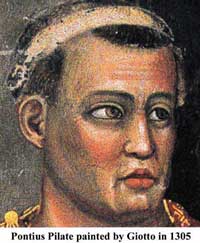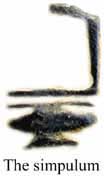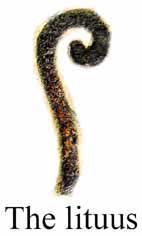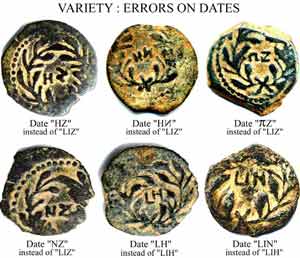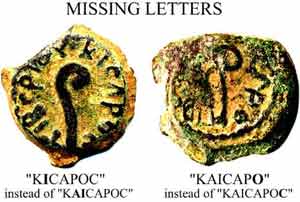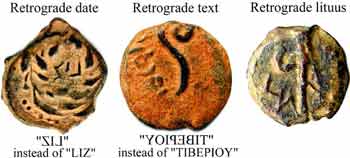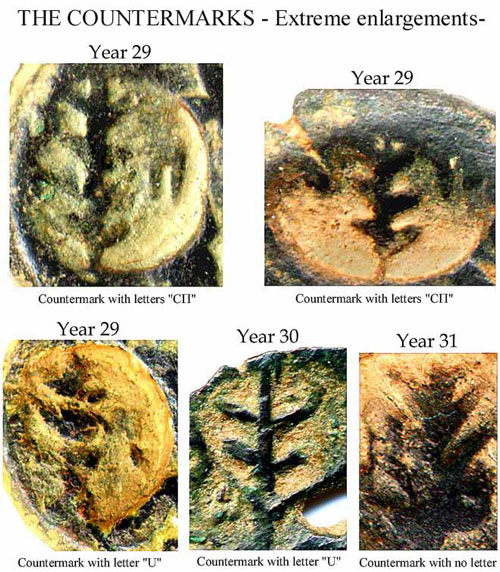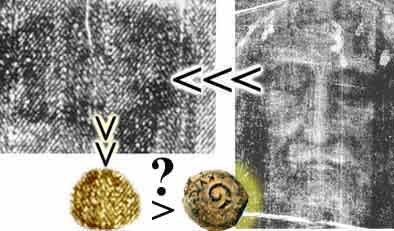| By Prof. Jean-Philippe FONTANILLE © 2001 All rights reserved Professor Fontanille may be reached by E-mail at jp.fontanille@sympatico.ca 1. INTRODUCTION 2 – The geographic proximity : The most credible hypothesis indicates that these particular coins where struck in Jerusalem, the city in which the significant events took place. 3 – The human proximity : Pontius Pilate himself designed and put the coins into circulation, and of course he was the man who conducted the trial and ordered the crucifixion of Jesus. So it is that everyone, whether a believer or simply a lover of history or of numismatics, will find in these coins direct evidence of and witness to an episode the memory of which has survived 2000 years : A momentous event which has to a great extent fashioned the world we know. Throughout this article we will also note the exceptional character of Pilate’s coins : Exceptional in the nature of the images they bear, for the numerous variants they offer, for the presence of countermarks, and above all for the part their originator played in history. The putative appearance of these coins imprints on the Turin shroud has yet to be confirmed by more solid scientific proofs. Pilate’s coins are Roman coins, the words on them are Greek, they were circulated in Judea, and today they are to be found distributed among world-wide collectors after having spent 2000 years buried in the earth. They were minted and used during a period which produced an event destined to change the face of the world, and issued at the command of one of the principal actors in that event. An amazing and dramatic destiny for apparently such humble and unassuming little coins ! In the sphere of numismatics, Pilate’s coins are at the opposite extreme of certain coins which are struck each year exclusively for collectors. Bright as Horse-guards’ buttons, these specially minted coins have never been used and never will be; their technical quality is immaculate but their historical value is negligible. For 35 years Pilate’s coins were passed from hand to hand every day. They knew the scent of spice-stalls, heard the merchants’ ranting, smelled the sweat and dust of daily works. They were alive to the sounds of Hebrew, Aramaic, Greek and Latin voices – now haggling over a price, now offering prayers to YHVH, Jesus or Jupiter. Nobody prays Jupiter any more, but Pilate’s coins are surviving witnesses to a time when the first Christians were considered as a messianic sect among several others in the midst of Judaism in crisis. The absolute split between Judaism and Christianity took place from about 70 C.E, the year which marked the tragic ending of the first Jewish rebellion. It was from that time, too, that Pilate’s money ceased to be used. Like each one of us, who carries always a few small coins in the bottom of our pockets; there is no doubt that some of Pilate’s coins resonated to the last words of the most famous of all supplicants. A very long story had its beginning…
Paradoxically, in spite of the evident problems of communication and understanding with the people, Pilate’s relations with the priestly authorities seem to have been good. As a governor he showed evidence of goodwill and of imagination, and it would appear that, unlike other procurators, he was not implicated in corrupt practices, either active or covert; there is nothing to show that he was either dishonest or treacherous. In the final analysis, his appointment was properly managed except his implication in the barbaric act which resulted in the ending of his mandate. It must be remembered, though, that severity and harshness were the normal order of the day in times long ago, difficult though this may be for us to comprehend in our actual democratic days of relative comfort. AN ORIGINAL HYPOTHESIS In the GBC, David Hendin mentions an original hypothesis put forward by Florence Aiken Banks. In a small way, I have allowed myself to supplement her assumption which is deduced from the images appearing on Pilate’s coinage which we will study in the following paragraphs. The theory is as follows : Before becoming prefect of Judea, Pontius Pilate followed the calling of soothsayer or seer. The Emperor Tiberius, well-known for the importance he attached to the interpretation of signs and portents, called up upon Pilate’s services for a number of years in the course of which a friendship and trust built up between the two men (even nowadays it is not unknown for certain heads of state to consult astrologers and rely on their advice !). The link between Emperor and foreteller finally resulted in the nomination of Pilate to the prefecture of Judea.
3. HOW PILATE’S COINS DIFFERED FROM OTHERS We should keep it clear in our minds that the coins of Pontius Pilate, like those of other prefects and procurators, bore neither his effigy nor his name. Only the emperor’s name and title appeared, although on the coin of year 29 the name of the emperor’s mother was inscribed. These inscriptions, to which the date was added, are written in Greek. Coins were the only means of introducing the name of the supreme authority into the conquered provinces in the most remote parts of the Empire. THE QUESTION OF DESIGN AND SYMBOLS The Pontius Pilate’s coinage was limited to only two models. The first struck in year 29, and the second in 30 then re-issued in 31. The date of issue was stamped on the coins; the complete collection of Pilate’s coins consist of only these three samples. Happily for collectors of coins, each of these issues presents numerous variations which are particularly interesting, and certain variants which are extremely rare; these will be detailed later. Pilate’s illustrations mark a total break with those of other prefects and procurators as well as with the all other monetary categories in circulation in Judea at this time. Even if Pilate hadn’t become known universally for his involuntary part in the origination of Christianity, he would still have had a special place in the domain of numismatics for the uniqueness of his coins. In effect, each of his coins presents on one of their faces an object associated with divination or Romans religious rites: the “simpulum” on the money of year 29, and the “lituus” on that of year 30 and 31. It must be admitted that when dealing with a nation so strongly attached to monotheism and who rejected any form of divination, it would have been hard to find a clumsier way of giving offence. Knowing, as we do, that the monies of other prefects and procurators conformed in general to the Law in using motifs recalling those of the Asmoneans and of the more respectful Herods, it is tempting to surmise that in the opinion of the Jewish population the coins were a provocation to both the people and their customs. PROVOCATION OR IGNORANCE ? The theory of provocation still seems rather implausible. Even if it is true that Pilate was ignorant of Jewish customs, it wasn’t in his interest to repeat an error of the same magnitude as that of the busts. He was most probably surrounded by counsellors who were well-informed of local beliefs. The immense Roman Empire had not been built by fools, but even nowadays we know quite well that certain ministries are directed more by civil servants than by the ministers themselves ! It must not be forgotten that relations between Pilate and the priestly authorities (who had not failed to manifest disapprobation in a similar situation) were not bad. Add that if Pilate had really wanted to offend the Jews with his coinage, he could quite well have engraved the Emperor’s portrait in the first instance using the pretext that Herod Philip done much the same in his little neighbouring kingdom. As I see it, the theory of provocation, even if it ought not to be discarded, rests on a fragile basis and we need to examine a certain number of inconsistencies which are hard to resolve. RESOLVING THE INCONSISTENCIES To my mind the hypothesis which seems the most probable is this : Pilate greatly wished to illustrate his coins with the simpulum and then the lituus because there were strong links which tied him personally to those symbols, as suggested by F.A. Banks; and not because he wanted to provoke anyone. Being aware of the incongruity of the chosen images in the context of local beliefs, he tempered the simpulum on the first issue by engraving three ears of barley on the reverse side, this being a harmless or neutral symbol so far as the Law was concerned. Moreover, the same dichotomy was evident when, in years 30 and 31, Pilate’s coins carried on one side the lituus and on the other a laurel wreath, another neutral motif which the Jews were long accustomed to seeing on their money. If it were possible to see into Pilate’s mind when he was choosing designs for his coinage, it would be easy to imagine him thinking : “One side for me, one side for them”. Another important element pleads in favour of mitigation of the potentially negative impact of the symbols: they are unrecognisable ! This impression is not only due to the (deliberate ?) simplicity of the drawing. Only the Roman citizen, familiar with the practices of divination and augury, would have been able to identify those objects with any certainty. There is no reason why things should have been fundamentally different for the Jewish people of that epoch. Like other people of antiquity, they were for the most part artisans, fishermen or farmers who had neither the means nor the need to acquire a high level of learning and for whom the life-style and behaviour of distant Rome were matters of indifference, and any case inaccessible. One cannot imagine the ordinary Jew expressing lively indignation each time he had to spend one of Pilate’s coins. What is more, the reverse face of the coins presented a familiar and conformist object which was easily identifiable. As for the priestly authorities, who were bound to have known the true significance of the symbols, we can reasonably suppose that they accepted the coins as a stop-gap. Taking into account the obstinate nature of a prefect who had the power to oversee their business, nobody was really interested in rocking the boat while relations were fairly good. Not just for a motif anyway. In addition, the credibility of the high priests themselves was at that time considerably reduce in the eyes of the people since they had been appointed by the Romans and were not true descendants of the Sadoq family. Thus, it seems quite reasonable to regard Pilate’s coins, long believed to be the provocative objects which they might at first seem, as being in reality a subtle compromise which would satisfy the Law (after a fashion), and, more profoundly, the will of the prefect. LOCATION OF MINTS Although the prefects had their residencies in Cesarea, the administrative capital of the province, it seems that their money was minted in Jerusalem. Indeed, a specimen dated year 31 has been found in this town in an incomplete state of manufacture. DURATION OF USE It would seem that Pilate’s money was in current use for at least 35 years. Indeed, some of it has been discovered among other coins during the excavation of remains of dwellings destroyed by the Romans during the first Jewish revolt, which is evidence that they were still in use at that time. AREA OF CIRCULATION These coins circulated far beyond the frontiers of Judea. Some samples have been discovered as far away as Antioch in present-day Turkey, nearly 500 kilometres from Jerusalem where they were minted. Others have also been found in Jordan. These limits represent a circulation area of at least 100.000 square kilometres, that is five times larger than the size of the state of Israel. Taking into account that it was a time when distances were expressed in terms of days of march, one begins to see the important influence of these coins. THE SIMPULUM A fairly frequent symbol from the Roman religion of the time, the simpulum was a utensil used by the priests during their religious ceremonies. This little ladle, provided with shaft and a handle, allowed the priests to taste the wine which they poured onto the head of an animal destined for sacrifice, after which the soothsayer was empowered to examine the animal’s entrails for signs and portents sent to men by the Gods through the medium of the interpreter. As I pointed, none of this would have been obvious at first sight of the motif except perhaps to a Roman citizen. However, it throws some light on the theory put forward by F.A. Banks. This wasn’t the first time that the simpulum appeared on Roman coins, but it is the first time it figured alone. This fact gives an additional specificity to Pilate’s coins, not only in the context of Judea but also in comparison with all the other coins of the Empire.
THE THREE EARS OF BARLEY The three ears or barley are featured on the opposing face of the simpulum. Unlike the simpulum, these ears of barley are not in contravention of the Jewish Law. The motif is nevertheless distinctive because it is the first time it appears on a Judean coin. The motif would reappear twelve years later on one of Herod Agrippa’s coin, then on another, much rarer, of Agrippa II (ears of barley held in a hand). After that, the motif disappeared altogether from ancient Jewish coins. We might ask why is it that the central ears is upright while the other two droop. The GBC mentions the possibility that Pilate wanted to symbolise his authority over the Jews, but it is possible that it was simply a matter of aesthetic choice. Nevertheless, it may be noted that on Agrippa I’s money, all three ears are upright : THE LITUUS The lituus is by way of being the “star” of Pilate coinage, not only because the two coins it illustrates (those of years 30 and 31) offer many more varieties than that of year 29 with the simpulum, but also because its form is sufficiently striking to remain engraved in the memory. Even more than the simpulum, the simpulum was a very important symbol of the Roman cults. It was carved on the frieze in the Temple of Jupiter the Thunderer at Rome. The lituus was the wooden staff which the augurs held in the right hand; it symbolised their authority and their pastoral vocation. It was raised toward heavens while the priests invoked the Gods and made their predictions. Legend records that Romulus used it at the time of Rome’s foundation in 753 B.C.E. It is interesting to note that the cross used in present times is the direct descendant of the lituus. As with the simpulum, Pilate’s coinage is exceptional in that it alone displays the lituus as the sole object illustrated on the face.
THE WREATH The laurel wreath is a symbol of power and victory, and figures on various ancient Greek and Roman coins. In Judea it can be found during the reign of John Hyrcanus I (134 to 104 B.C.E.). After that, Herod Antipas, speaker for Pilate, used it on all his coins. On Pilate’s coins, the laurel wreath figures on the reverse side of the lituus, framing the date. THE DATES The notation of dates uses a code invented by the Greeks whereby each letter of the alphabet was assigned a number. This code would be used again in Judaism under the name of Guematria. The system is simple : the first ten letters of the alphabet are linked to units (1,2,3…), the following ten letters to tens (10,20,30…) and the four remaining letters to the first four hundreds. Thus the date is always inscribed beginning with an “L”, an abbreviation meaning “year”. Pilate’s three coins all follow this with an “I” (the tenth letter of the Greek alphabet, associated with the number 10), to indicate that the first decade of the reign of Tiberius has passed; after which Pilate’s first coinage bore a “V” associated with 6, which shows that we are in the sixteenth year of Tiberius’ reign. The second coinage’s date ended with a “Z”, or number 7 (17th year of Tiberius’ reign), and finally, the third of Pilate’s coinages ended with an “H”, or number 8 (18th year of Tiberius’ reign). Tiberius became emperor on September 17 of year 14 C.E, so we have : LIS = Year 29 C.E. THE TEXTS The legends on Pontius Pilate’s coins are written in Greek. Judea, governed by the Ptolemy dynasty (301 to 198 B.C.E) then by the Syrians until 63 B.C.E, came under the same powerful influence of the Hellenic culture which touched the other territories of the ancient Persian Empire won by Alexander the Great. In spite of a certain amount of resistance, this Hellenistic heritage eventually crept into every aspect of daily life. Apart from the dates, the texts on Pilate’s coinage consisted of only three different words : – TIBEPIOY KAICAPOC (Of Tiberius Emperor) on all three coins; THE VARIETIES The varieties on Pilate’s coins are a fascinating subject of study. The most spectacular are those with retrograde motifs, with errors in texts or dates. These faults
THE COUNTERMARKS Throughout the world only thirteen specimens of Pilate’s coins are listed as bearing countermarks. Three of them can be found in Israel’s museums, and the other ten The countermarks represent a branch of the palm tree flanked by Greek letters “C”, or “Cpi” or “U”. According to the most credible hypothesis, the most frequent The countermarks were therefore stamped by the Roman legions purpose connected with military affairs. It is noticeable that the engravers took care to save the
PILATE’S COINS AND TURIN SHROUD We will not enter into the arguments between the partisans and the adversaries of the authenticity of this shroud. An immense amount of literature has already been One might well say that the Turin shroud guards its mystery to this day. Could it be possible that new developments may come from so unexpected a field as It all began at NASA in 1978. At this time researchers Jackson, Jumper and Stephenson wanted to test the capacities of their VP8 new computer, specially for Everything then happened very quickly. The following year Professor Francis Filas, a teacher at Loyola University of Chicago, made an enlargement of the image of In 1980, an electronic analysis performed in the Overland Park Laboratory in Texas confirmed not only the soundness of Professor Filas’ findings, but also allowed What credibility may be given to these “discoveries” ? Like everything else touching on the Turin Shroud, each discovery, whether in favour of its authenticity or For my part, I must admit that I have failed to detect any trace of the year 29 coin on the right eye. On the other hand, the similarity of the centre left eye image to a A remarkable web site : www.shroud.com/lombatti.htm presents all the details of this controversy (more than 20 pages)
Bibliography 1. Pilate coins and varieties : 2. The Countermarks on Pilate’s coins : 3. Pilate coins and Turin shroud : |
| Professor Fontanille may be reached by E-mail at jp.fontanille@sympatico.ca |

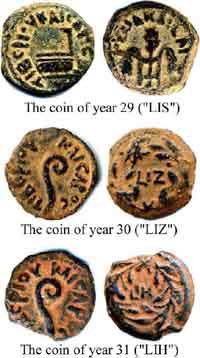 When in 26 C.E. the Emperor Tiberius appointed Pontius Pilate to be Prefect of Judea, the territory had already been under Roman domination for nearly a century. The least that we can say is that the man was rather harsh. His mindset and culture were typically Roman, and it would have been difficult to reconcile his attitude with that of the Jews, whose beliefs and customs he never understood, and for which he had little regard or interest.
When in 26 C.E. the Emperor Tiberius appointed Pontius Pilate to be Prefect of Judea, the territory had already been under Roman domination for nearly a century. The least that we can say is that the man was rather harsh. His mindset and culture were typically Roman, and it would have been difficult to reconcile his attitude with that of the Jews, whose beliefs and customs he never understood, and for which he had little regard or interest.